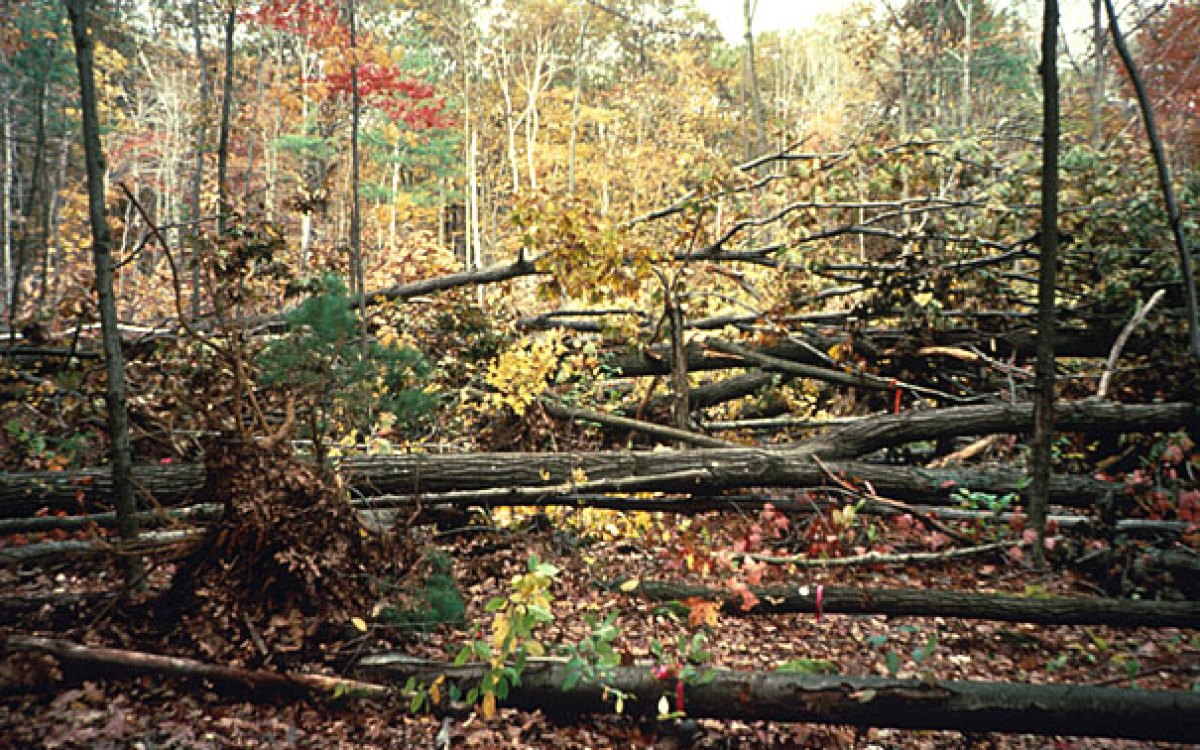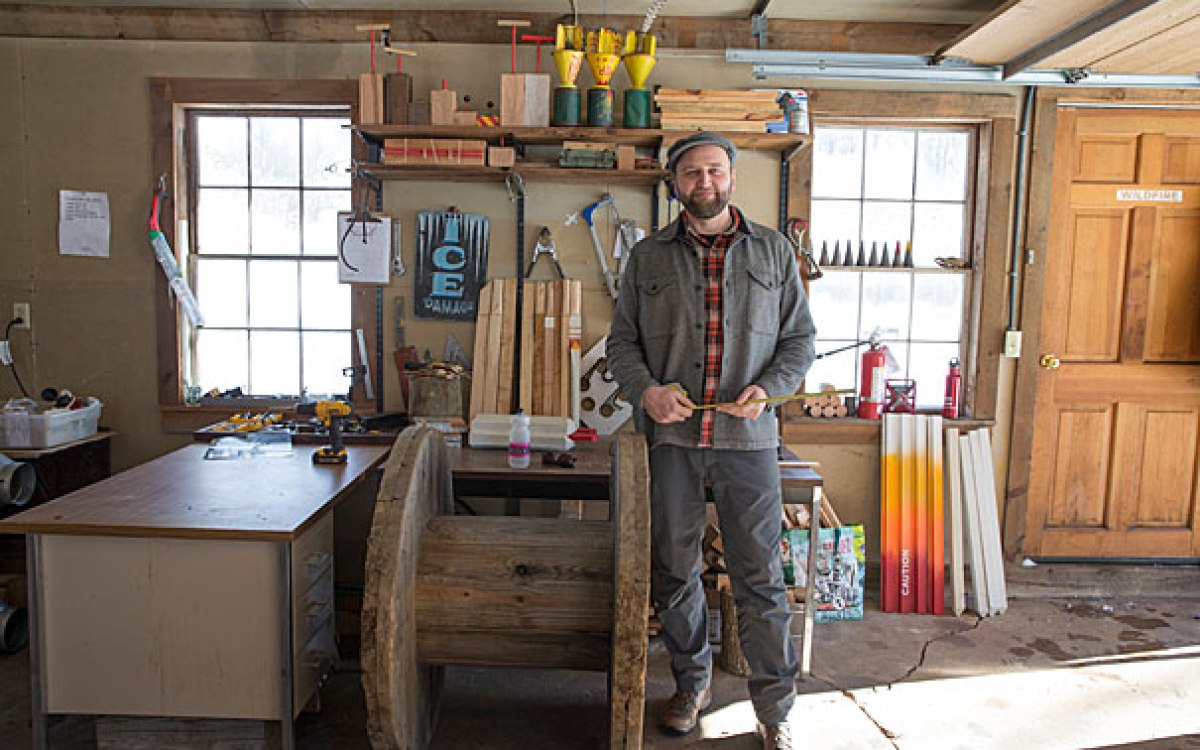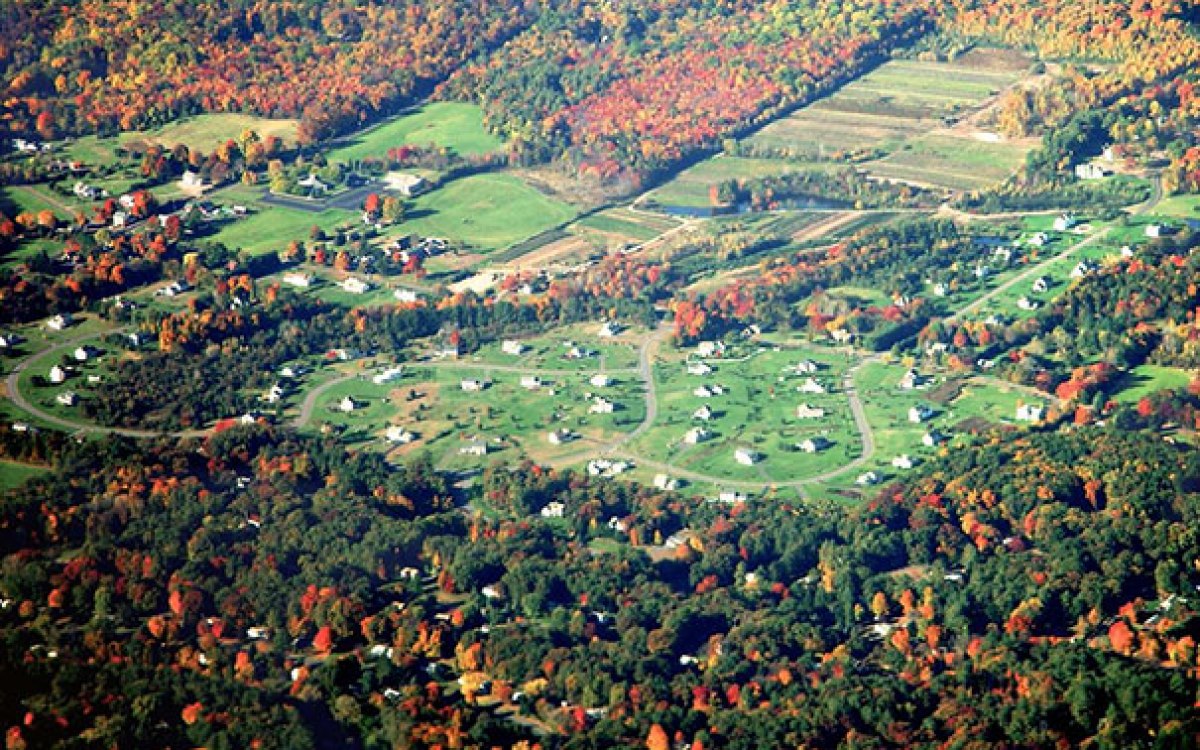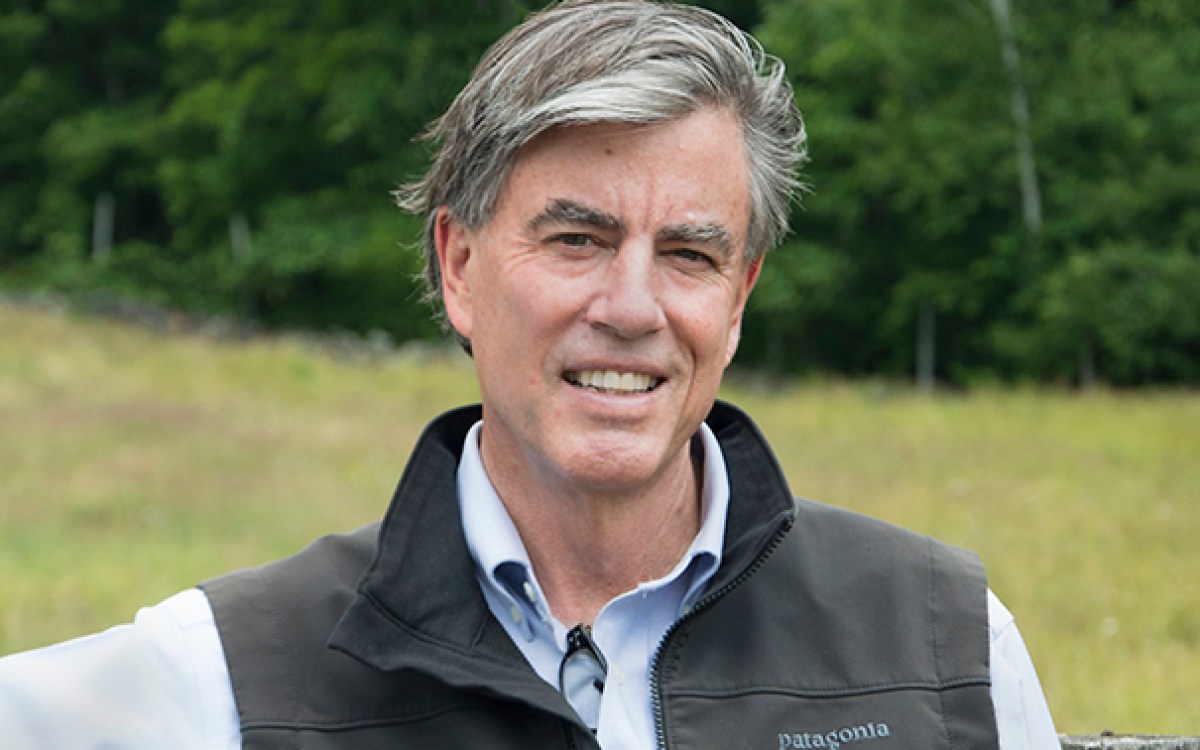Video by Justin Saglio/Harvard Staff
Scientists are blown away by hurricane experiment’s results
Decades after Harvard Forest researchers decided to simulate effects of a giant storm, nature is still surprising in how it has rebounded
Nearly 30 years ago, Harvard Forest scientists began a unique, long-running experiment on a 2-acre forest tract using a long steel cable, a winch, and a heavy-duty logging vehicle called a skidder.
One by one, they dragged the cable to 279 selected trees, attached it high on the trunk, and then radioed the guy at the skidder, parked outside the tract to avoid disturbing the forest floor, to trigger the winch. And, one by one, the trees came down.
When they were done, they had approximated the damage done across New England by the Great Hurricane of 1938, creating an experimental hurricane that affected 50 percent of the large canopy trees, opened the understory to new light, kick-started a decades-long recovery process, and created a nightmare landscape of fallen trunks and crisscrossed branches more easily traversed by a parkour expert than scientists charged with regularly recording the changes to come.
By March 2019, the nightmare had largely subsided. The forest floor was still strewn with decomposing trunks, but their slow return to the soil had advanced enough that they were easily traversed by some two dozen scientists and visitors who gathered in the snow-covered experimental plot, in Harvard Forest’s Tom Swamp Research Tract in Petersham, Massachusetts.
Around them were trees that, while younger and thinner than those they replaced, had long ago closed the gaps in the forest canopy. They were similar in makeup to those prior to the storm — a surprise for researchers expecting more pioneer species to take hold. Also remarkable was just how unremarkable the tract looked. It was like many other New England deciduous forests, bare and awaiting spring’s leaf-out on a chilly late-winter morning.
In fact, that ordinariness — an expression of the stability of the New England forest ecosystem, even in the wake of a once-in-a-century calamity — was another key lesson, along with the finding that forests managed as natural environments are best left to recover themselves rather than being helped along by the “salvage logging” widespread after the 1938 storm and still common after blowdowns, fires, and tree-killing insect infestations today.
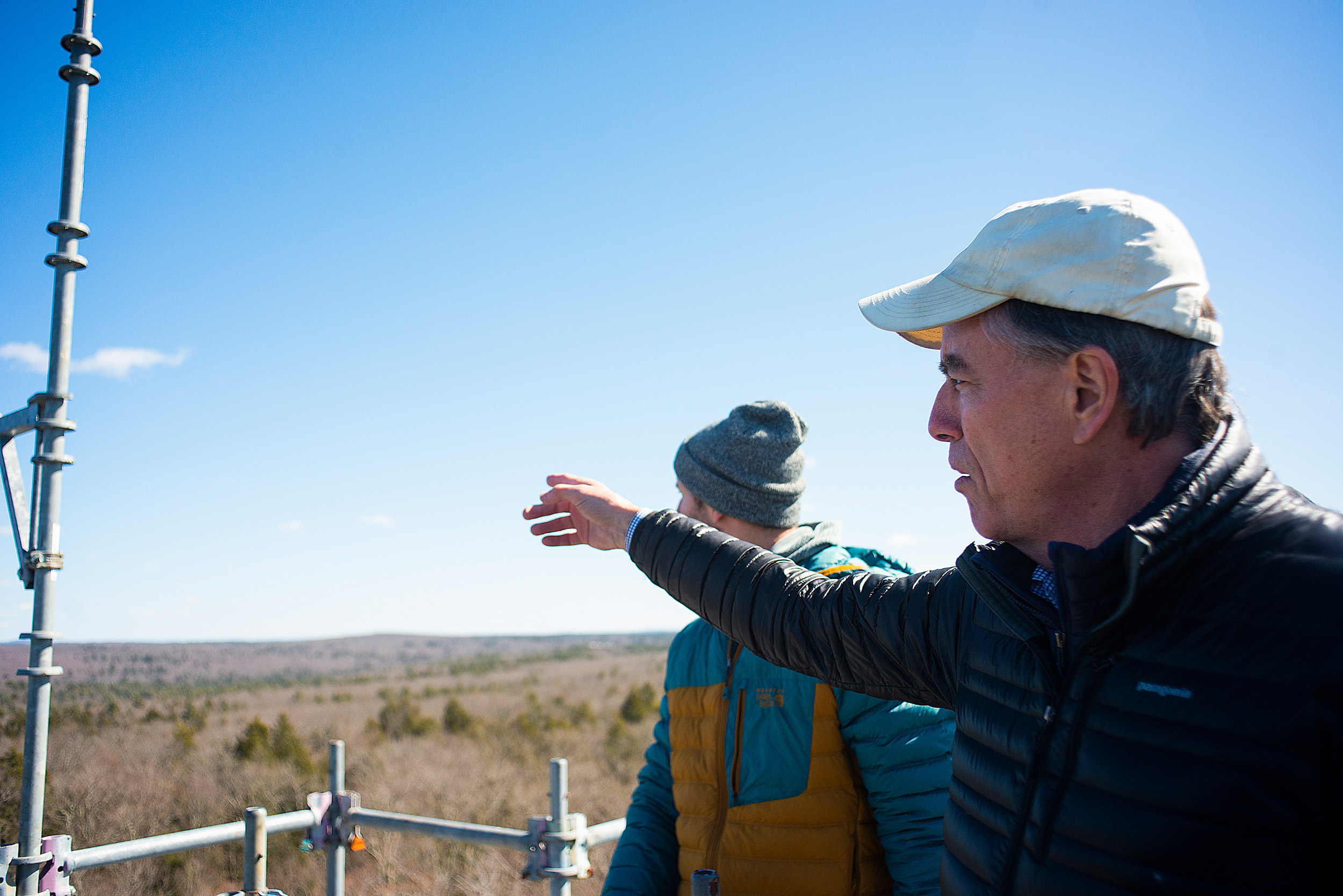
Harvard Forest David Foster surveys the landscape from atop a data-collection tower.
Kai-Jae Wang/Harvard Staff
The scientists, hailing from Harvard Forest and associated institutions, gathered that morning to reflect on the conduct of the experiment, major findings, and the importance of such research, which requires a patient, long-view commitment from funding sources, from host institutions like Harvard Forest, and from the scientists themselves, a view increasingly rare in an impatient, results-now world.
Addressing the assemblage that morning, Harvard Forest Director David Foster said that the hurricane experiment was important not just because of the science it enabled, but also because it was one of the first and most striking after Harvard Forest’s designation as a Long Term Ecological Research site (LTER) by the National Science Foundation in 1988.
That designation, renewed at six-year intervals, has provided a foundation of financial support — about $1 million annually — for work like the experimental hurricane, and leverages between five and 10 times that in funding from other agencies. The LTER projects are also a focal point for educational programs at the forest, including both K‒12 and College-level programs. Thousands of Harvard students have visited during field trips, worked at the sites during the Summer Research Program, and studied their findings in Foster’s first-year seminar in global change biology.
On March 18 and 19, Harvard Forest hosted a two-day event marking the 30th anniversary of its LTER designation. The first day was dedicated to site visits and the second to a daylong scientific symposium, with detailed presentations of results so far to 125 attendees. Today, Harvard Forest is one of 28 LTER sites across the country, part of a network that may be little known to the public but that ecologists revere.
“These are storied places for ecologists,” said Harvard Forest senior ecologist Jonathan Thompson, who recently took over from Foster as principal investigator for the forest’s LTER grant. “There’s nothing like them.”
“Despite the fact that this looked like a destroyed forest, because it was physically altered in such a major way, it was functioning as an absolutely intact ecosystem.”
Harvard Forest Director David Foster
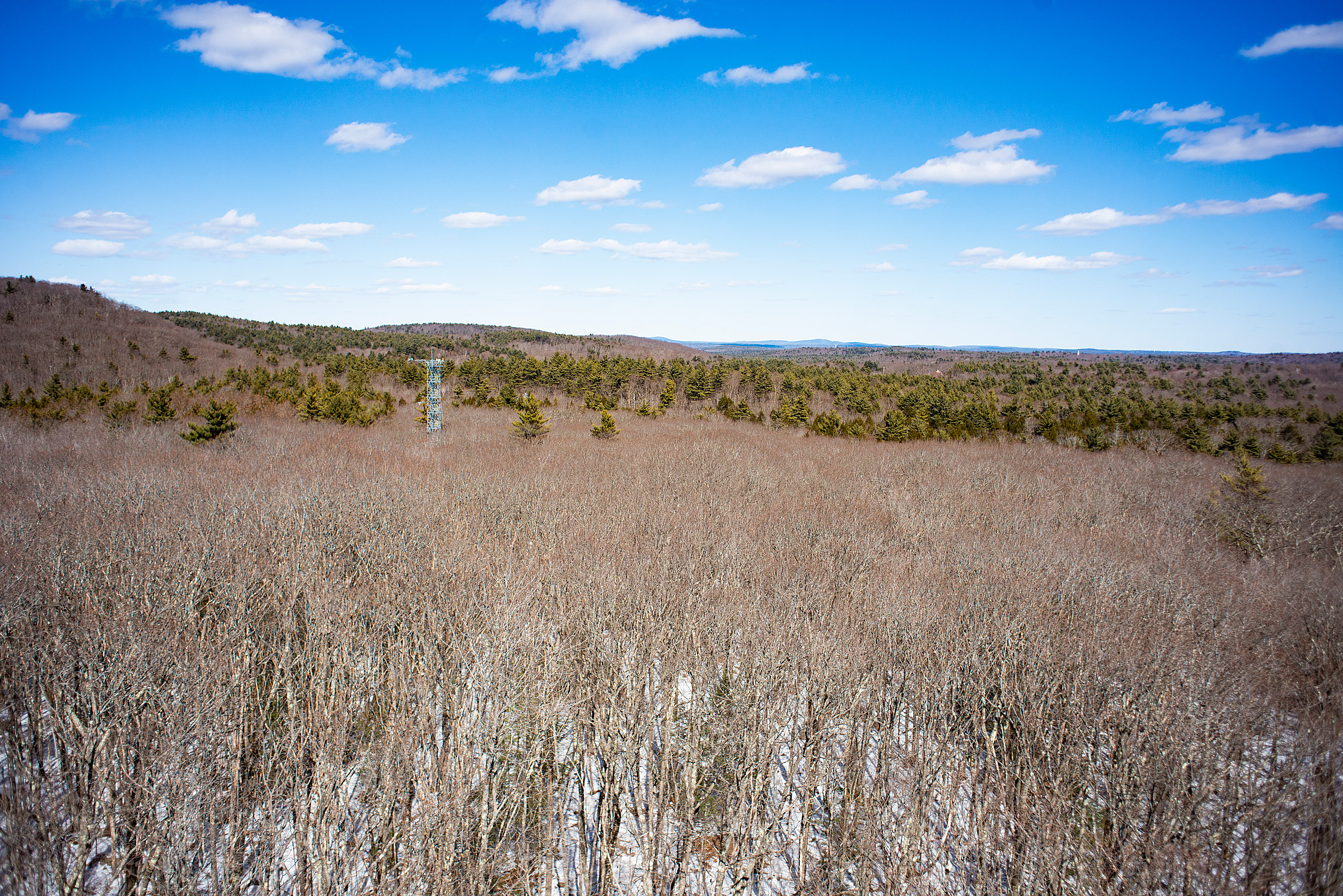
Kai-Jae Wang/Harvard Staff
After viewing the hurricane blowdown, scientists loaded into vans headed for other experiments along the narrow dirt tracks that intersect the 4,000-acre forest. One stop was a stand of towering evergreens — hemlocks being monitored by senior ecologist David Orwig. Hundreds of years old and never logged, the hemlocks’ days are nonetheless numbered because of assault by the invasive woolly adelgid, whose penetration this far north has been facilitated by the region’s ever-warming winters.
The group visited the Environmental Monitoring Site, where the world’s first research tower was built to measure the intake and outflow of gases as the forest breathes. Research at the tower, pioneered by Steven Wofsy, Harvard’s Abbott Lawrence Rotch Professor of Atmospheric and Environmental Science, and now overseen by senior research fellow in atmospheric chemistry J. William Munger, showed that recovering forests like New England’s — clear-cut in Colonial times — are helping fight climate change by locking atmospheric carbon in their wood as the trees grow thicker and push higher.
The day ended at a checkerboard of brown on the snowy forest floor. The snowless plots are the hallmark of a long-running experiment in soil warming. Using heated cables buried underground, the nearly 30-year-old effort seeks to understand how soil microbes and respiration from tree roots might respond to a warming world.
Maintained at 5 degrees Celsius above the surrounding soil to mirror the high end of warming estimates for the end of the century, the plots have shown that the warmed microbes and roots kick into high gear, rapidly increasing the amount of carbon released that had been locked up in the soil. After reaching a peak, the emissions declined, stabilized for several years, and then — in yet another experimental surprise — rose to a second peak.
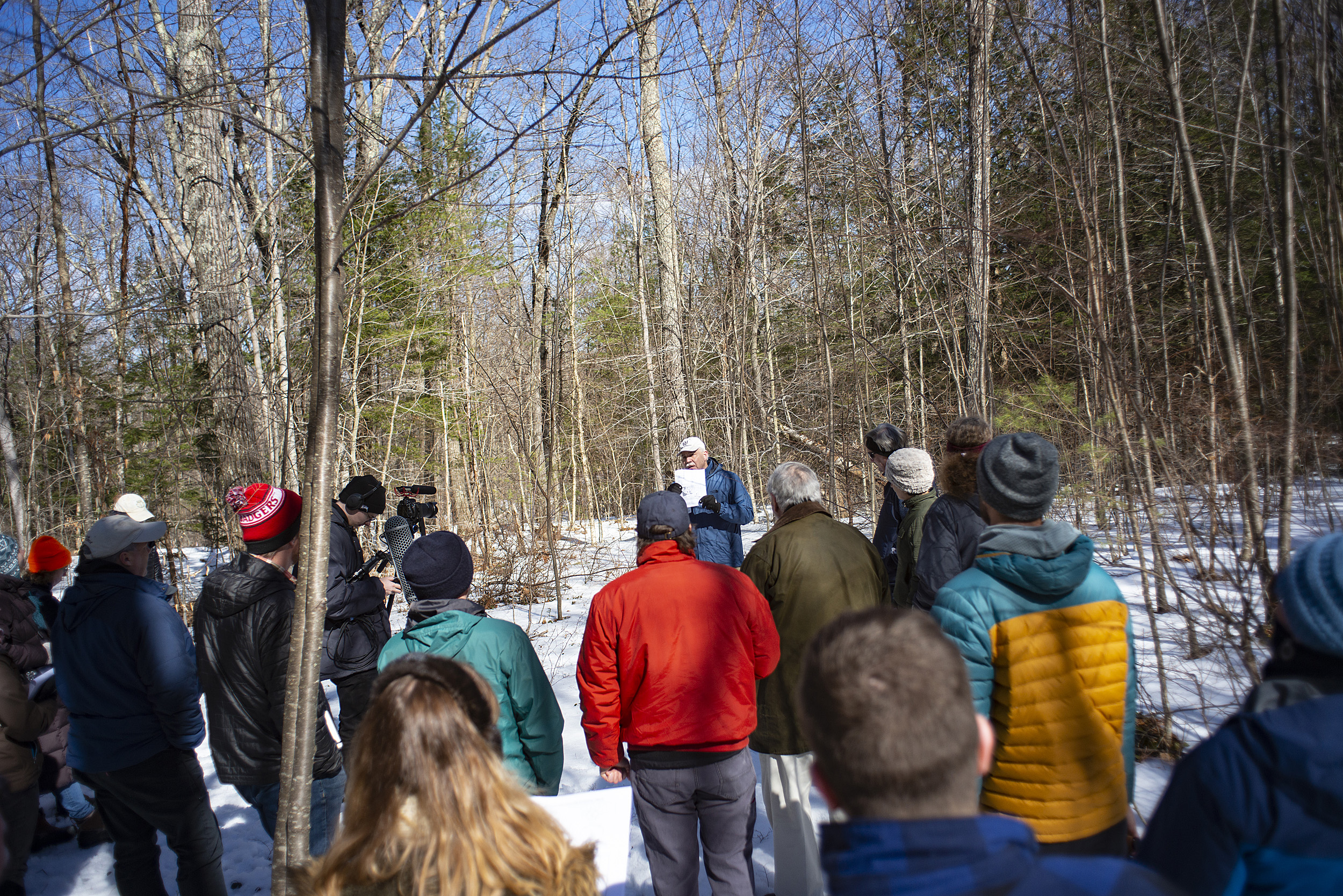
Tim Sipe (center, facing camera) speaks as part of a series of Harvard Forest events marking its 30th anniversary as a Long Term Ecological Research site.
Kai-Jae Wang/Harvard Staff
“We figured we have a three-phase phenomenon and we have continued making measurements,” said Jerry Melillo, distinguished scientist at the University of Chicago’s Marine Biological Laboratory and a senior investigator at the forest. “We are now in a second quiescent period. Another 20 or 30 years we’ll probably get close to an answer.”
Melillo said the LTER funding was critical to the experiment, first because it provided important foundational money that was augmented by funding from other sources like the U.S. Department of Energy. Then, when interest waned after the first peak of carbon emissions subsided, the LTER funding kept the experiment running. Without it, Melillo said, the second burst of carbon emissions — and the improved understanding of warming’s effects on forest soils — would have gone unnoticed.
LTER and a ‘signature experiment’
Melillo, who has conducted research at Harvard Forest for 40 years, played an important role in getting the initial LTER experiments up and running, Foster said. Not long after the LTER designation, Melillo counseled that the forest needed something exciting to help it stand out.
“‘What we need is a signature experiment,’” Foster recalled Melillo saying. “‘We need something that they’ll talk about at NSF, that’ll be unlike something that anybody else has done.’
“I said, ‘Jerry, what is that?’ And he said, ‘I don’t know, but we gotta have it.’”
Foster eventually seized on replicating one of the most devastating forces that mold the New England forest landscape: major hurricanes that blast ashore every 100 to 150 years. But how to do it? He rejected the idea of bulldozing trees because it would tear up the forest floor and disrupt the invisible but nonetheless critical cycling of nutrients and gases between the floor and the atmosphere.
When Foster suggested winching trees down instead, the idea was ridiculed as unworkable by a visiting scientist: The roots were far too strong. Foster chewed over the problem until he mentioned it to John Wisnewski, a Harvard Forest staffer with experience logging.
“‘I’d just pull them over,’” Foster recalled Wisnewski saying. “‘We do it all the time.’”
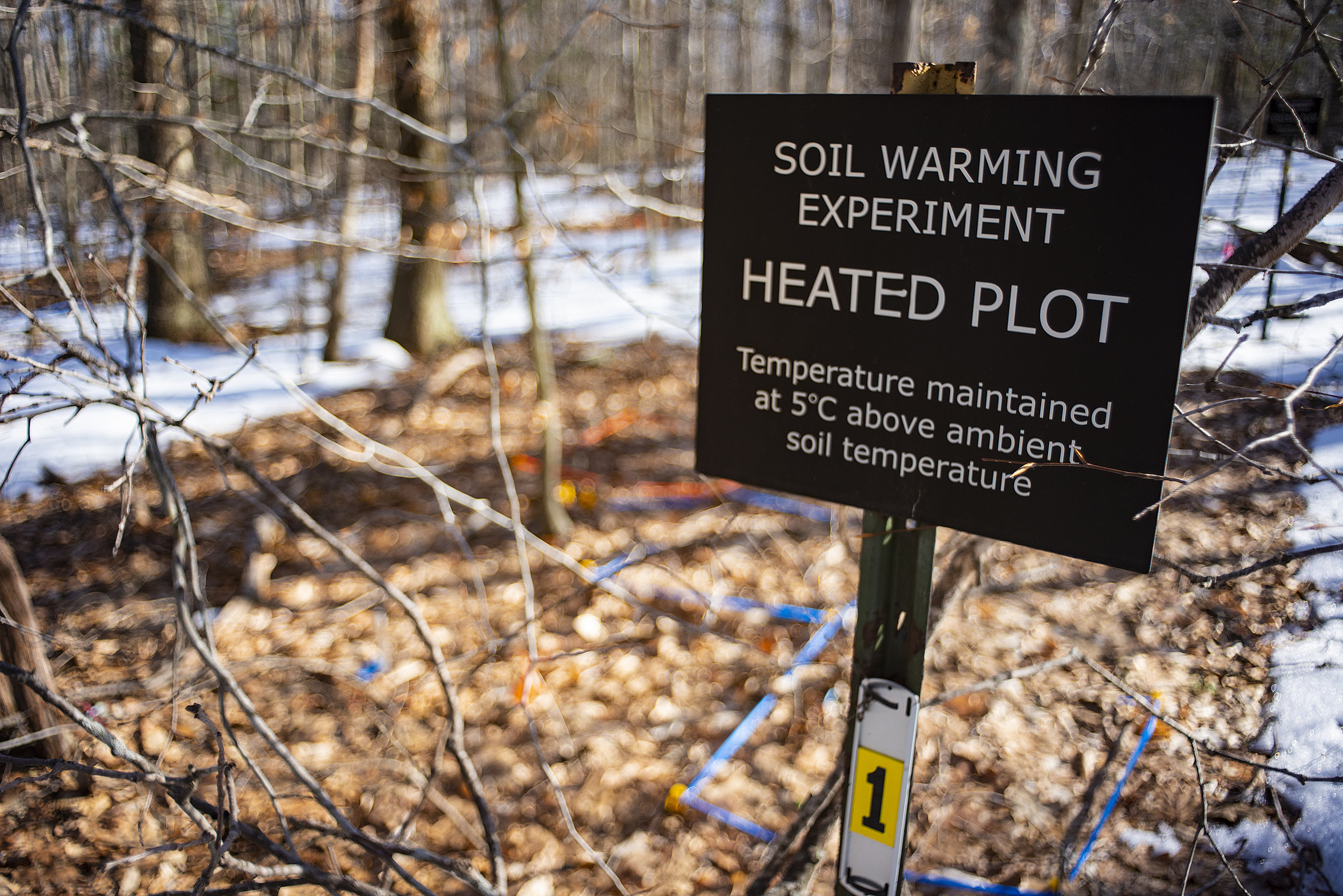
A sign marks a 20-year heated soil experiment.
Kai-Jae Wang/Harvard Staff
Wisnewski, today Harvard Forest’s woods crew supervisor, told Foster that loggers need a flat area to stage removal of logs from the forest. So instead of cutting trees, which would leave stumps behind, they simply pull them down with a winch and cable, lop off the trunks, and pile the roots to one side.
An experimental path cleared, Foster turned to the forest’s archive to plan the simulated storm In 1938, graduate student Willett Rowland recorded the Great Hurricane’s damage at the forest, showing that about half of the large trees came down and that some species, such as white pine, were more susceptible to wind damage.
With that knowledge in hand, Foster laid out an east-west plot 50 meters by 160 meters in the Tom Swamp tract and marked the trees to come down. Preparations complete, they drove in the skidder and hauled the cable into the forest, pulling down tree after tree, all oriented so their crowns pointed northwest, as if felled by a hurricane’s prevailing winds.
Most trees came right over, Foster said, but some broke and were left to regrow as they were. Only one tree — a large old oak — resisted the skidder’s tow.
“We decided that, well, in a hurricane that tree wouldn’t have fallen,” Foster said. “We went and found one of equal size downslope and pulled it over.”
Then began the lengthy task of monitoring. An early revelation was the stability of key indicators like soil temperature, overall productivity, and carbon dioxide and nitrogen gas cycling among the trees, the soil, and the atmosphere.
Another was that the trees didn’t die right away. Ninety percent of trees damaged by the winch leafed out regardless, photosynthesizing, drawing water from the earth, and contributing to the forest ecosystem even though they were flat on the ground. As they slowly died, the understory took over. Saplings that had been awaiting their chance shot upward, sprouts grew from the fallen trees’ roots, and newly seeded trees got started. Lost production — measured in the amount of leaf litter each fall — recovered in just six years.
“Despite the fact that this looked like a destroyed forest, because it was physically altered in such a major way, it was functioning as an absolutely intact ecosystem,” Foster said.
In trying to understand the forest’s unexpected stability, researchers realized that most experience with disturbed sites was at places subjected to the common practice of salvage logging, where fallen trees are cut and dragged out using soil-churning heavy equipment. In some cases, as after the 1938 hurricane, the piled debris left behind is burned.
“We’re used to looking at sites that were subsequently disturbed after a major wind storm or ice storm by people going in and logging,” Foster said. “The 1938 hurricane was the biggest salvage logging exercise in U.S. history. And it pretty comprehensively turned the 1938 hurricane into one great big cutting operation.
“In almost every case you can think of, if your intent is to encourage the recovery of the forest and ecosystem function with minimal change … doing nothing becomes a viable alternative.”
When Audrey Barker-Plotkin arrived at the site eight years after the pulldown, just walking around was a challenge. Today a senior researcher and the author of several studies on the site, she recalled having to weave through tangled branches and wrestle with wiry new growth that all seemed to be at “face level.”
“It was like walking through a jungle gym. The plot seems a lot smaller now that you can see through it,” Barker-Plotkin told the visiting scientists. “Just the changes I’ve seen in 20 years have been really remarkable. … [The site] was different every single year.”
Another thing scientists didn’t expect, Barker-Plotkin said, was the stability of the tract’s species makeup. Researchers thought that more pioneer species like cherry and paper birch — usually fast-growing colonizers of disturbed sites — would take hold. But the stability of even the damaged ecosystem didn’t provide much of an opening. While those species did appear in disturbed soil around upturned roots, that was less than 10 percent of the forest floor. Invasive species, another threat at disturbed sites, were also absent, she said.
Today, she said, the experimental plot has largely recovered structurally, but is still struggling to catch up with the surrounding forest’s growth. Tree volume has reached about 80 percent of what it was before the pulldown, but measurements of the nearby control plot show that the surrounding forest has grown 25 percent over the intervening decades as part of New England forests’ continued recovery from Colonial-era clear-cutting.
New leaders and a landscape full of questions
Like the long-term processes they measure, the hurricane pulldown and other experiments continue to produce data even as their original investigators’ careers come to a close. A smooth transition to new leadership will be essential in maintaining both research continuity and excellence, Foster said. At several sites the group visited, experimental founders handed off presentations to younger researchers, as Foster did to Barker-Plotkin at the hurricane site and Melillo did to University of New Hampshire Professor Serita Frey, a soil microbe expert, at the soil warming experiments.
LTER’s new principal investigator, Thompson, spoke of the importance of ensuring the continuity of key long-term experiments even as researchers move on from work that has run its scientific course.
“In some ways, the experiments they set up in the ’80s just look so prescient now,” he said.
An important question still to be explored is how long recovering forests will keep absorbing carbon, Thompson added. That answer has potentially crucial implications for climate change, since global forests absorb roughly 20 percent of the excess carbon humans emit.
Part of the problem, Thompson said, is that though remnant old-growth patches exist, they may not be good models for understanding forests regrowing on former farmland, since they’re typically in poor growing locations, which is why they weren’t cut in the first place.
“We know how much [carbon] is in the forests,” Thompson said, “but we don’t know how much carbon can be in these forests.”



